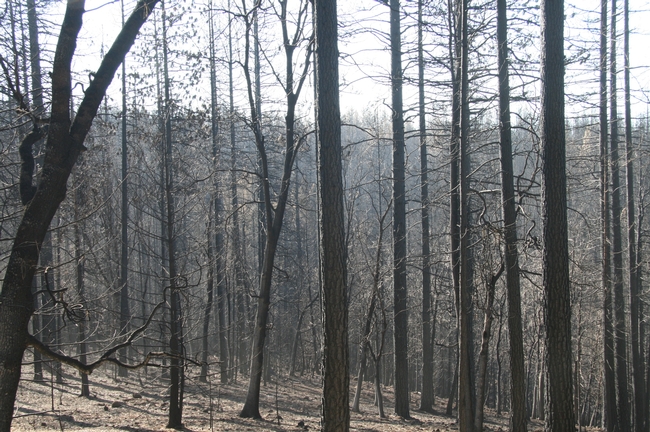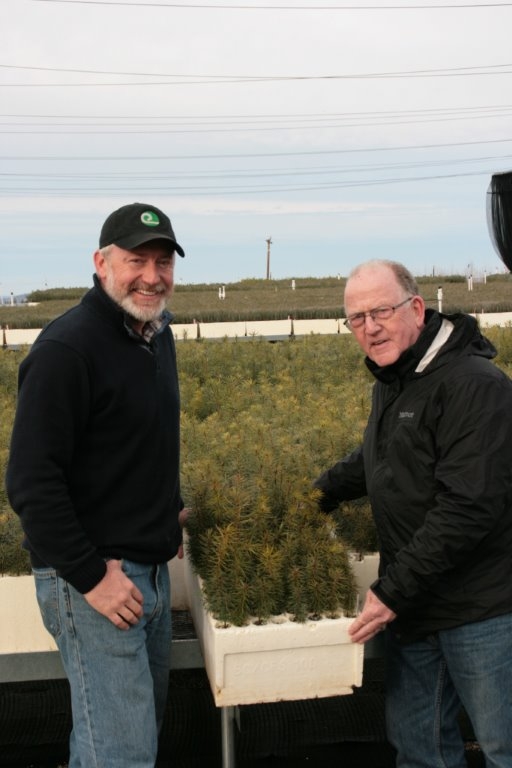Posts Tagged: Lake County
Lake County plants 100,000 seeds to reforest area destroyed by Valley Fire
Lake County community groups have raised nearly $60,000 to reforest the areas ravaged by last September's Valley Fire. The funds have allowed the greenhouse planting of 100,000 native conifer seedlings that will be ready for distribution in time for the winter 2016 planting season. The Valley Fire, which started in Cobb on Sept. 12, burned more than 76,000 acres.
In October, Greg Giusti, UC ANR Cooperative Extension director and forestry advisor in Lake County, and Korinn Woodard, district conservationist with the Natural Resources Conservation District (NRCS), began to estimate the numbers of seeds needed for the first year of planting.
Two local entities have provided funds to jumpstart the much-needed reforestation in the areas affected by fire. #LakeCountyRising is a collaborative fundraising effort of the Lake County Winegrape Commission, Lake County Winery Association and Lake County Wine Alliance. The Lake Area Rotary Club Association (LARCA) is a nonprofit foundation that comprises the four Rotary Clubs in Lake County – Lakeport, Middletown, Clearlake and Kelseyville. Together they have allocated the nearly $60,000 to the East Lake Resource Conservation District (RCD) to get the seedlings planted and the program in place.
By collaborating with the El Dorado/Georgetown Divide RCD's established native-plant seed collection and propagation program, the funds have resulted in the greenhouse planting of 100,000 native conifers – mostly ponderosa pine, but also some Douglas fir and sugar pine. The species available are suitable for higher elevation burned areas such as Cobb Mountain.
“Getting our forest lands replanted as soon as possible is a cornerstone in the healing process of the spirit of these communities,” said Andy Peterson, chair of the LARCA Fire Relief Committee. “The LARCA Fire Relief Committee identified that as a top priority from day one and we are extremely pleased to be partnering with these other agencies to get that done.”
#LakeCountyRising representatives were interested in helping to support the effort, but any donation would need to go to an established organization responsible for the program. At the same time, LARCA had also identified funding for reforestation efforts as a major priority.
“An experienced agency was needed to lead this effort, and our board agreed that we had the experience and resources to make it happen, if funds were available,” said Charlotte Griswold, East Lake RCD president.
This is where #LakeCountyRising and LARCA stepped up to the plate. Timing was of the essence, as seeds would need to be purchased in time for winter planting in order to have seedling stock available by late 2016.
“It was evident there was urgency, so we presented it to our steering committee and they wholeheartedly supported it,” said Debra Sommerfield, president of the Lake County Winegrape Commission, one of the three organizations involved in the #LakeCountyRising fundraising effort.
“The intention is to make conifer seedlings available for planting each winter for the next few years at a pace that will align with the community rebuilding process and demand,” Griswold said. “We expect to work with NRCS to start taking advance orders before the end of April and to partner with the ag and natural resources programs at area high schools to organize several community planting projects.”
UC helps community develop local food systems
The movement in Lake County to encourage local citizens to consume locally produced agricultural products got a boost last month when a diversity of experts brought in ideas that have worked elsewhere in the state, according to a story in Lake County News.
Food systems analyst Gail Feenstra of the UC Sustainable Agriculture Research and Education Program explained how schools in Davis, Calif., increased students' fruit and vegetable consumption by tying the salad bar selections to school garden lessons.
To help fund the program, the coordinators turned food scraps into compost for the gardens. By reducing the amount of garbage, they saved the district $60,000 – enough to fund their positions and subsidize the gardens.
City of Davis voters also passed a parcel tax to help subsidize the program, finding it worthwhile to ensure all students were served nutritious lunches made from locally grown foods, the article said.
Shermain Hardesty, extension specialist for agricultural and resource economics at UC Davis, presented information at the gathering on establishing local food systems.
"Building things from scratch, by yourself, costs money. Look for partnerships using existing resources," Hardesty was quoted in the article.
She led an interactive exercise asking participants what was missing in Lake County's local food system, with grains, meat and dairy the most often mentioned. The group then discussed what infrastructure was needed to create local industries that would meet these needs.
Other projects supporting local agriculture addressed at the workshop were:
- The Lake County Community Co-Op, an online distribution system that enables members to order certified organic products directly from local producers
- “Lake County Grown,” sponsored by Lake County Farm Bureau, for online ordering of local produce
- The LAVA Center, which buys overages and blemished produce from farmers and adds value by turning it into another product, such as sauces or chutneys.



